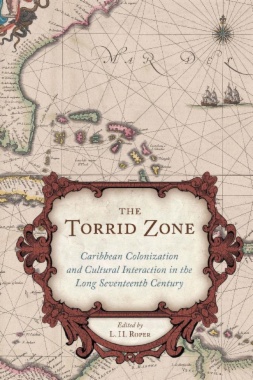The first comparative treatment of settlers' trading, pirating, and colonizing activities in the Caribbean
Brimming with new perspectives and cutting-edge research, the essays collected in The Torrid Zone explore colonization and cultural interaction in the Caribbean from the late 1600s to the early 1800s—a period known as the "long" seventeenth century—a time when these encounters varied widely and the diverse actors were not yet fully enmeshed in the culture and power dynamics of master-slave relations. The events of this era would profoundly affect the social and political development both of the colonies that Europeans established in the Caribbean and the wider world.
This book is the first to offer comparative treatments of Danish, Dutch, English, and French trading, pirating, and colonizing activities in the Caribbean and analysis of the corresponding interactions among people of African, European, and Native origin. The contributions range from an investigation of the indigenous colonization of the Lesser Antilles by the Kalinago to a look at how the Anglo-Dutch wars in Europe affected relations between the English inhabitants and the Dutch government of Suriname. Among the other essays are incisive examinations of the often-neglected history of Danish settlement in the Virgin Islands, attempts to establish French colonial authority over the pirates of Saint-Domingue, and how the Caribbean blueprint for colonization manifested itself in South Carolina through enslavement of Amerindians and the establishment of plantation agriculture.
The extensive geographic, demographic, and thematic concerns of this collection shed a clear light on the socioeconomic character of the "Torrid Zone" before and during the emergence and extension of the sugar-and-slaves complex that came to define this region. The book is an invaluable contribution to our understanding of the social, political, and economic sensibilities to which the operators around the Caribbean subscribed as well as to our understanding of what they did, offering in turn a better comprehension of the consequences of their behavior.
- Cover�������������������������������
- The Torrid Zone�������������������������������������������������������������
- Title�������������������������������
- Copyright�������������������������������������������
- Contents����������������������������������������
- Acknowledgments�������������������������������������������������������������
- Introduction����������������������������������������������������
- Part I Indigenous and Other Caribbeans����������������������������������������������������������������������������������������������������������������������������������
- Kalinago Colonizers: Indigenous People and the Settlement of the Lesser Antilles����������������������������������������������������������������������������������������������������������������������������������������������������������������������������������������������������������������������������������������������������������������
- Aphra Behn’s Oroonoko, Indian Slavery, and the Anglo-Dutch Wars�������������������������������������������������������������������������������������������������������������������������������������������������������������������������������������������������������������
- Indigeneity and Authority in the Lesser Antilles: The Warners Revisited�������������������������������������������������������������������������������������������������������������������������������������������������������������������������������������������������������������������������������������
- Part II Empire, Settlement, and War in the Torrid Zone: The Cases of Suriname, Jamaica, Danish West Indies, and Saint-Domingue����������������������������������������������������������������������������������������������������������������������������������������������������������������������������������������������������������������������������������������������������������������������������������������������������������������������������������������������������������������������������������������������������������
- Second Is Best: Dutch Colonization on the “Wild Coast”����������������������������������������������������������������������������������������������������������������������������������������������������������������������������������
- Colonial Life in Times of War: The Impact of European Wars on Suriname����������������������������������������������������������������������������������������������������������������������������������������������������������������������������������������������������������������������������������
- Reassessing Jamayca Española: Spanish Fortifications and English Designs in Jamaica�������������������������������������������������������������������������������������������������������������������������������������������������������������������������������������������������������������������������������������������������������������������������
- Making Jamaica English: Priorities and Processes����������������������������������������������������������������������������������������������������������������������������������������������������������������
- The Danish West Indies, 1660s–1750s: Formative Years����������������������������������������������������������������������������������������������������������������������������������������������������������������������������
- Creating a Caribbean Colony in the Long Seventeenth Century: Saint-Domingue and the Pirates�������������������������������������������������������������������������������������������������������������������������������������������������������������������������������������������������������������������������������������������������������������������������������������������������
- Part III Extending the Torrid Zone����������������������������������������������������������������������������������������������������������������������
- The Martinican Model: Colonial Magistrates and the Origins of a Global Judicial Elite�������������������������������������������������������������������������������������������������������������������������������������������������������������������������������������������������������������������������������������������������������������������������������
- Experimenting with Acceptance, Caribbean-Style: Jews as Aliens in the Anglophone Torrid Zone����������������������������������������������������������������������������������������������������������������������������������������������������������������������������������������������������������������������������������������������������������������������������������������������������
- Carolina, the Torrid Zone, and the Migration of Anglo-American Political Culture����������������������������������������������������������������������������������������������������������������������������������������������������������������������������������������������������������������������������������������������������������������
- Notes�������������������������������
- Bibliography����������������������������������������������������
- Contributors����������������������������������������������������
- Index�������������������������������

